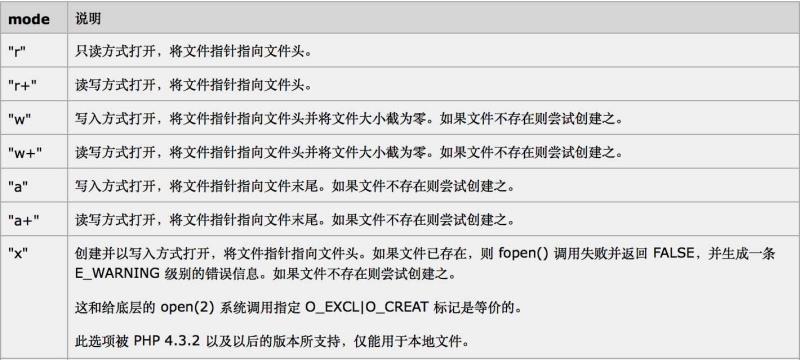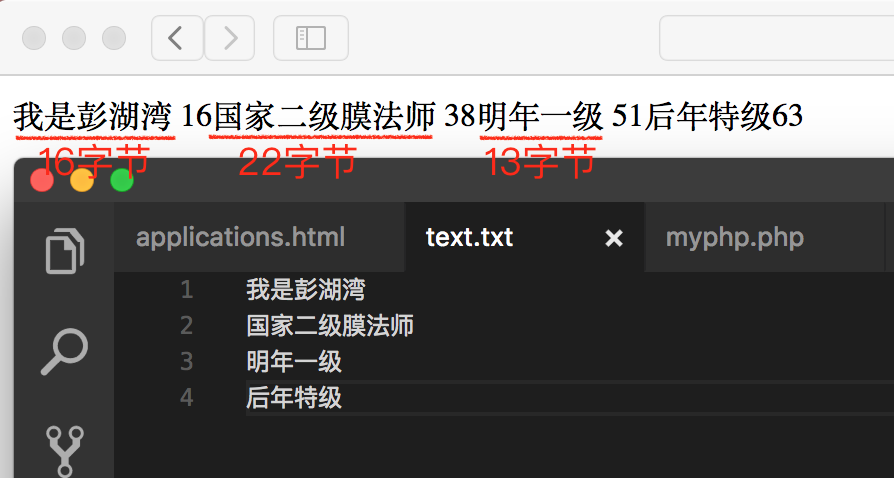文章提纲:
二.使用fopen方法打开文件
四.使用fclose方法关闭文件
五.文件指针的移动
六.windows和unix下的回车和换行
1.通过fopen方法打开文件:$fp =fopen(/*参数,参数*/),fp为resource类型
2.进行文件读取或者文件写入操作(这里使用的函数以1中返回的$fp作为参数)
3. 调用fclose($fp)关闭关闭文件
二:使用fopen方法打开文件
fopen(文件路径[string],打开模式[string])
<1>fopen的第一个参数为文件路径
写文件路径的方式:1绝对路径,2相对路径
1绝对路径:
在windows下工作的小伙伴们应该很熟悉,windows下的路径分隔符是“\\”而不是“/”,但我们在写入路径时不能以钦定的“\\”为分隔符
|
1
2
3
|
<?php
$fp = fopen("c:\\wamp64\\www\\text.txt",'w');
?>
|
|
1
2
3
|
<?php
$fp = fopen("c:/wamp64/www/text.txt",'w');
?>
|
运行时无报错,说明参数是有效的。
【注意】fopen函数不能理解“\\”分隔符,如果你想要使用“\\”,那么要使用转义,如写成:"c:\\\\wamp64\\\\www\\\\text.txt"这种写法也是可以的,函数也能理解,不会报错。但即使这样,也不推荐使用“\\”,因为在os(mac)下只能识别“/”不能识别“\\”
本小节的结论:推荐坚持使用“/”作为分隔符
2.相对路径:
上一小节介绍的是绝对路径的写法,但这样却带来了另外一个问题:服务器的目录结构可能会有较大的改变,这时原来写的绝对路径就要全部重写了,比如在我的电脑上的目标文件路径是c:/wamp64/www/text.txt,如果我把www文件夹改名为penghuwan呢?原来写入的路径参数就失效了。所以我们引入了相对路径的写法:
|
1
2
3
4
|
<?php
$document_root = $_server['document_root'];
$fp = fopen("$document_root/text.txt",'w');
?>
|
• $_server是php的超级全局变量(在代码任何地方都可访问,类型是数组),通过$_server['document_root']可取到服务器的默认根目录
服务器的默认根目录可通过php.ini修改(这个可自行百度)
• $_server['document_root']在这里等同于c:/wamp64/www
本小节的结论:推荐使用相对路径
<2>fopen的第二个参数为打开模式
设置打开模式后,我们就相当于为接下来的读写操作设置了权限:
最基本的几个模式:
“r”:只能读取文件,不能写入文件(写入操作被忽略)
“w”:只能写入文件,不能读取文件(读取操作被忽略)
“a”:只追加文件,与“w”类似,区别是“w”删除原有的内容,“a”不删除原有内容,只追加内容
|
1
2
3
4
5
6
|
<?php
$document_root = $_server['document_root'];
$fp = fopen("$document_root/text.txt",'w');
fwrite($fp,'在写模式下写入');
fclose($fp);
?>
|

|
1
2
3
4
5
6
|
<?php
$document_root = $_server['document_root'];
$fp = fopen("$document_root/text.txt",'r');
fwrite($fp,'在读模式下写入');
fclose($fp);
?>
|


很全面,但我觉得这张表对新手有些不太友好,让人看后不知多云。 r是只读,w是只写(原来有的内容全删除),a是追加(不删除原有内容),这都好理解。
|
1
2
3
4
5
6
|
<?php
$document_root = $_server['document_root'];
$fp = fopen("$document_root/text.txt",'r+');
fwrite($fp,'r+ mode');
fclose($fp);
?>
|
|
1
2
3
4
5
6
|
<?php
$document_root = $_server['document_root'];
$fp = fopen("$document_root/text.txt",'a+');
fwrite($fp,'a+ mode');
fclose($fp);
?>
|
•采用w+模式写入文本“w+ mode”
|
1
2
3
4
5
6
|
<?php
$document_root = $_server['document_root'];
$fp = fopen("$document_root/text.txt",'w+');
fwrite($fp,'w+ mode');
fclose($fp);
?>
|

|
1
2
3
4
5
6
7
8
9
10
11
|
<?php
$document_root = $_server['document_root'];
$fp = fopen("$document_root/text.txt",'r');//打开文件
if(file_exists("$document_root/text.txt")){//当文件存在时,才读取内容
while(!feof($fp)){//判断文件指针是否到达末尾
$c = fgetc($fp);//每执行一次fgetc(),文件指针就向后移动一位
echo $c;//输出获取到的字节
}
}
fclose($fp);//关闭文件
?>
|

|
1
2
3
4
5
6
|
<?php
$document_root = $_server['document_root'];
$fp = fopen("$document_root/text.txt",'r');
echo fgetc($fp);//只做一次输出
close($fp);
?>
|

|
1
2
3
4
5
6
7
8
|
<?php
$document_root = $_server['document_root'];
$fp = fopen("$document_root/text.txt",'r');
echo fgetc($fp);//连续做三次输出
echo fgetc($fp);
echo fgetc($fp);
fclose($fp);
?>
|
2.一次读取多个字节 ——通过fread()方法:
|
1
2
3
4
5
6
|
<?php
$document_root = $_server['document_root'];
$fp = fopen("$document_root/text.txt",'r');
echo fread($fp, 3);//一次输出三个字节即一个汉字字符(utf-8)
fclose($fp);
?>
|
改成:
|
1
|
echo fread($fp, 6);
|

|
1
2
3
4
5
6
7
8
9
10
11
|
<?php
$document_root = $_server['document_root']
$fp = fopen("$document_root/text.txt",'r');//打开文件
if(file_exists("$document_root/text.txt")){//当文件存在时,才读取内容
while(!feof($fp)){//判断文件指针是否到达末尾
$line = fgets($fp);//返回一行文本,并将文件指针移动到下一行头部
echo $line."<br/>";//输出获取到的一行文本
}
}
fclose($fp);//关闭文件
?>
|
|
1
|
$line = fgets($fp,10);
|

|
1
2
3
4
5
6
|
<?php
$document_root = $_server['document_root'];
$fp = fopen("$document_root/text.txt",'r');
fpassthru($fp);
fclose($fp);
?>
|

|
1
2
3
4
5
6
7
|
<?php
$document_root = $_server['document_root'];
$file_array = file("$document_root/text.txt");//取到文件数组
foreach ($file_array as $value) {//输出数组元素
echo $value."<br/>";
}
?>
|
|
1
2
3
4
5
6
7
8
9
10
11
12
13
14
15
16
17
18
19
20
21
22
23
24
25
26
27
28
|
<?php
$document_root = $_server['document_root'];
function print_file_pointer($fp){//定义一个打印文件指针位置的函数
echo " <br/>//此时文件指针的位置:";
echo ftell($fp)."<br/>";
}
$fp = fopen("$document_root/text.txt",'r');
echo fgetc($fp);//通过fgetc连续输出三个字节
echo fgetc($fp);
echo fgetc($fp);
print_file_pointer($fp);//打印此刻文件指针的位置
echo fread($fp,6);//通过fread一次输出6字节
print_file_pointer($fp);//打印此刻文件指针的位置
echo fgets($fp); //通过fgets输出一整行
print_file_pointer($fp);//打印此刻文件指针的位置
fpassthru($fp); //一次性输出全部内容
print_file_pointer($fp);//打印此刻文件指针的位置
fseek($fp, 33);//使文件指针移动到33字节位置
print_file_pointer($fp);//打印此刻文件指针的位置
rewind($fp);//使文件指针移动到0字节位置(初始位置)
print_file_pointer($fp);//打印此刻文件指针的位置
$fclose($fp);
?>
|

|
1
2
3
4
5
6
7
8
9
|
<?php
$document_root = $_server['document_root'];
$fp = fopen("$document_root/text.txt",'r');
while(!feof($fp)){
echo fgets($fp);
echo ftell($fp);
}
fclose($fp);
?>
|

相关文章
- ASP.NET自助建站系统的数据库备份与恢复操作指南 2025-06-10
- 个人网站服务器域名解析设置指南:从购买到绑定全流程 2025-06-10
- 个人网站搭建:如何挑选具有弹性扩展能力的服务器? 2025-06-10
- 个人服务器网站搭建:如何选择适合自己的建站程序或框架? 2025-06-10
- 64M VPS建站:能否支持高流量网站运行? 2025-06-10
- 2025-07-10 怎样使用阿里云的安全工具进行服务器漏洞扫描和修复?
- 2025-07-10 怎样使用命令行工具优化Linux云服务器的Ping性能?
- 2025-07-10 怎样使用Xshell连接华为云服务器,实现高效远程管理?
- 2025-07-10 怎样利用云服务器D盘搭建稳定、高效的网站托管环境?
- 2025-07-10 怎样使用阿里云的安全组功能来增强服务器防火墙的安全性?
快网idc优惠网
QQ交流群
-
2025-05-25 94
-
2025-05-29 89
-
2025-05-27 25
-
2025-05-29 70
-
2025-05-27 57




















